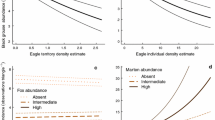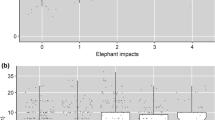Abstract
The predator–prey relationship plays an integral role in community structure. In the presence of habitat fragmentation, the dynamic interaction among co-existing species may be disrupted. In this paper we investigated the interaction between small skinks resident in open woodland remnants and the predatory birds that cross-forage between the remnants and the surrounding peri-urban matrix. Skinks were found in significantly fewer numbers in the edge of remnants compared to their core. In contrast, predatory birds were in largest numbers at the edge compared to the core of remnants. We found that there was a strong negative correlation between skink numbers and predatory birds (individually and combined) consistent with higher predation pressure in the edge compared to the core of remnants. Strike rates on decoys that mimicked skinks were also higher in the edge compared to core habitats, consistent with higher predation rates in this edge habitat.



Similar content being viewed by others
References
Abensperg-Traun M, Smith GT, Arnold GW, Steven DE (1996) The effects of habitat fragmentation and livestock-grazing on animal communities in remnants of gimlet Eucalyptus salubris woodland in the Western Australian wheat belt I Arthropods. J Appl Ecol 33:1281–1301. doi:10.2307/2404770
Anderson L, Burgin S (2002) The influence of woodland remnant edges on small skinks (Richmond, New South Wales). Austral Ecol 27:630–637. doi:10.1046/j.1442-9993.2002.01224.x
Andrén H, Angelstam P (1988) Elevated predation rates as an edge effect in habitat islands: experimental evidence. Ecology 69:544–547. doi:10.2307/1940455
Bagchi S, Sankar K (2003) Prey abundance and prey selection by tigers (Panthera tigris) in a semi-arid, dry deciduous forest in western India. J Zool 260:285–290. doi:10.1017/S0952836903003765
Baiada A (2002) Determining biological indicators to define edge-zones within remnants of the Cumberland Plain. Honours, University of Western Sydney, Richmond
Barker RD, Vestjens WJM (1984a) The food of Australian birds, non-passerines. Melbourne University Press, Melbourne
Barker RD, Vestjens WJM (1984b) The food of Australian birds, passerines. Melbourne University Press, Melbourne
Barrows CW, Allen MF (2007) Persistence and local extinctions of endangered lizard Uma inornata on islated habitat patches. Endanger Species Res 3:61–68. doi:10.3354/esr003061
Barrows CW, Allen MF, Rotenberry JT (2006) Boundary processes between a desert sand dune community and an encroaching suburban landscape. Biol Conserv 131:486–494. doi:10.1016/j.biocon.2005.12.024
Benson DH, Howell J (1990) Sydney’s vegetation 1788–1988: utilization, degradation and rehabilitation. Proc Ecol Soc Aust 16:115–127
Berry L (2001) Edge effects on the distribution and abundance of birds in a southern Victorian forest. Wildl Res 28:239–245. doi:10.1071/WR00057
Bider JR (1968) Animal activity in uncontrolled terrestrial communities as determined by a sand transect technique. Am Midl Nat 97:216–221
Bragg JG, Taylor J, Fox BJ (2005) Distributions of lizard species across edges delimiting open-forest and sand-mined areas. Austral Ecol 30:188–200. doi:10.1111/j.1442-9993.2005.01436.x
Brown GW, Nelson JL (1993) Influence of successional stage of Eucalyptus regnans (Mountain Ash) on habitat use by reptiles in the Central Highlands, Victoria. Aust J Ecol 18:405–417. doi:10.1111/j.1442-9993.1993.tb00468.x
Burgin S (1989) The taxonomy and phylogenetic relationship of Australian Scincid lizards (Scincidae: Lygosominae). Ph.D., Macquaire University: Sydney
Burgin S (1993) Lampropholis: the new laboratory animals. In: Lunney D, Ayers D (eds) Herpetology in Australia: a diverse discipline. Transactions of the Royal Zoological Society of N.S.W. Royal Zoological Society of NSW, Mosman, pp 279–282
Burgin S (in press). A natural history of the Ham Common, the lands sandwiched between Richmond and Windsor – two of Governor Macquarie’s five towns. In: Lunney D, Hutchings P, Hochuli D (eds) A natural history of Sydney. Royal Zoological Society of NSW, Mosman
Cardinale BJ, Weis JJ, Forbes AE, Tilmon KJ, Ives AR (2006) Biodiversity as a cause and consequence of resource availability: a study of reciprocal causality in a predator-prey system. J Anim Ecol 75:497–505. doi:10.1111/j.1365-2656.2006.01070.x
Catterall C (2004) Birds, garden plants and suburban bushlots: where good intentions meet unexpected outcomes. In: Lunney D, Burgin S (eds) Urban wildlife: more than meets the eye. Royal Zoological Society of NSW, Mosman, pp 21–31
Catterall CP, Green RJ, Jones DN (1991) Habitat use by birds across a forest-shrub interface in Brisbane: implications for corridors. In: Saunders DA, Hobbes RJ (eds) Nature conservation 2: the role of corridors. Surrey Beatty and Sons Pty Ltd, Chipping Norton, pp 247–258
Catterall CP, Piper SD, Bunn SE, Arthur JM (2001) Flora and fauna assemblages vary with local topography in a subtropical Eucalypt forest. Austral Ecol 26:56–69. doi:10.1046/j.1442-9993.2001.01074.x
Chace JF, Walsh JJ (2006) Urban effects on native avifauna: a review. Landsc Urban Plan 74:46–69. doi:10.1016/j.landurbplan.2004.08.007
Clarke KR, Ainsworth M (1993) A method linking multivariate community structure to environmental variables. Mar Ecol Prog Ser 92:205–219. doi:10.3354/meps092205
Clarke KR, Warwick RM (2001) Changes in marine communities: an approach to statistical analysis and interpretation, 2nd edn. Plymouth Marine Laboratory , Plymouth
Cogger HG (2000) Reptiles and amphibians of Australia. Reed New Holland, Sydney
Delibes M, Ferreras P, Gaona P (2001) Attractive sinks, or how individual behavioural decisions determine source-sink dynamics. Ecol Lett 4:401–403. doi:10.1046/j.1461-0248.2001.00254.x
Donnellan SC (1985). The evolution of sex chromosomes in Scincid lizards. PhD, Macquarie University, Sydney
Downes S, Shine R (2001) Why does tail loss increase a lizard’s later vulnerability to snake predators? Ecology 82:1293–1303
Dyer SJ, O’Neil JP, Wasel SM, Boutin S (2001) Avoidance of industrial development by woodland caribou. J Wildl Manage 65:531–542. doi:10.2307/3803106
Fischer J, Lindenmayer DB, Cowling A (2004) The challenge of managing multiple species at multiple scales: reptiles in an Australian grazing landscape. J Appl Ecol 41:32–44. doi:10.1111/j.1365-2664.2004.00869.x
Goldingay R, Daly G, Lemckert F (1996) Assessing the impacts of logging on reptiles and frogs in the Montane forests of southern New South Wales. Wildl Res 23:495–510. doi:10.1071/WR9960495
Grey MJ, Clarke MF, Loyn RH (1998) Influence of the noisy miner Manorina melanocephala on avian diversity and abundance in remnant Grey Box Woodland. Pac Conserv Biol 4:55–69
Higgins PJ (ed) (1999) Handbook of Australian, New Zealand and Antarctic Birds: parrots to dollarbirds. Oxford University Press, South Melbourne
Higgins PJ, Davies SJJF (eds) (1996) Handbook of Australian, New Zealand and Antarctic Birds: snipe to pigeons. Oxford University Press, South Melbourne
Higgins PJ, Peter JM, Steele WK (eds) (2001) Handbook of Australian, New Zealand and Antarctic Birds: tyrant to flycatchers. Oxford University Press, South Melbourne
Hutchinson MN, Donnellan SC, Baverstock PR, Krieg M, Simms S, Burgin S (1990) Immunological relationships and generic revision of the Australian lizards assigned to the genus Leiolopisma (Scincidae: Lygosominae). Aust J Zool 38:535–554. doi:10.1071/ZO9900535
James T (1997) Urban bushland biodiversity survey: Western Sydney. NSW National Parks and Wildlife Service, Hurstville
Kremsater L, Bunnell FL (1999) Edge effects: theory, evidence and implications to management of western North American forests. In: Wisniewski J, Rochelle J, Lehmann L (eds) Forest fragmentation: wildlife and management implications. Leiden, Boston, pp 117–153
Langkilde T, Shine R (2004) Competing for crevices: interspecific conflict influences retreat-site selection in montane lizards. Behav Ecol 140:684–691
Lin LJ, Qu Y-F, Ji X (2006) Energetic and locomotor costs of tail loss in Chinese skink Eumeces chinensis. Comp Biochem Physiol A 143:503–513
Lunney D, Eby P, O’Connell M (1991) Effects of logging, fire and drought on three species of lizards in Mumbulla State Forest on the south coast of New South Wales. Aust J Ecol 16:33–46. doi:10.1111/j.1442-9993.1991.tb01479.x
Major RE, Christie FJ, Gowing G (2001) Influence of remnant and landscape attributes on Australian woodland bird communities. Biol Conserv 102:47–66. doi:10.1016/S0006-3207(01)00090-8
Mather PB (1990) Electrophoretic and morphological comparisons of Lampropholis delicata (Lacertilia: Scincidae) populations fro east Australia, and a resolution of the taxonomic status of the species. Aust J Zool 37:561–574. doi:10.1071/ZO9890561
Mather PB, Hughes JM (1992) Genetic variations in three species in the Lampropholis delicata (Lacertilia: Scincidae) complex. Biol J Linn Soc Lond 47:135–146. doi:10.1111/j.1095-8312.1992.tb00660.x
Miller DA, Grand JB, Fondell TF, Anthony M (2006) Predator functional response and prey survival: direct and indirect interactions affecting a marked prey population. J Anim Ecol 75:101–110. doi:10.1111/j.1365-2656.2005.01025.x
Molsher RL, Gifford EJ, McIlroy JC (2000) Temporal, spatial and individual variation in the diet of red foxes (Vulpes vulpes) in central New South Wales. Wildl Res 27:593–601. doi:10.1071/WR99015
Norrdahl K, Korpimaki E (2000) Do predators limit the abundance of alternative prey? Experiments with vole-eating avian and mammalian predators. Oikos 91:528–540. doi:10.1034/j.1600-0706.2000.910315.x
Parsons H, Major RE, French K (2006) Species interaction and habitat associations of birds inhabiting urban areas of Sydney, Australia. Austral Ecol 31:217–227. doi:10.1111/j.1442-9993.2006.01584.x
Pizzey G, Knight F (1997) The field guide to birds of Australia. Angus and Robertson, Pymble
Sewell SR, Catterall CP (1998) Bushland modification and styles of urban development: their effects on birds in south-east Queensland. Wildl Res 25:41–63. doi:10.1071/WR96078
Shepard DB (2007) Habitat but not body shape affects predator attack frequency on lizard models in the Brazilian Cerrado. Herpetologica 63:193–202. doi:10.1655/0018-0831(2007)63[193:HBNBSA]2.0.CO;2
Shirley SM, Smith JNM (2005) Bird community structure across riparian buffer strips of varying width in a coastal temperate forest. Biol Conserv 125:475–489. doi:10.1016/j.biocon.2005.04.011
Singh S, Smyth AK, Blomberg SP (2002) Effect of a control burn on lizards and their structural environment in a Eucalypt open-forest. Wildl Res 29:447–454. doi:10.1071/WR01015
Taylor JE, Fox BJ (2001) Disturbance effects from fire and mining produce different lizard communities in eastern Australian forests. Austral Ecol 26:193–204. doi:10.1046/j.1442-9993.2001.01105.x
Tozer M (2003) The native vegetation of the Cumberland Plain, western Sydney: systematic classification and field identification of communities. Cunninghamia 8:1–155
Webb GA (1995) Effects of logging on lizards in Eucalypt forest at Eden, New South Wales. Aust For 58:155–159
White JG, Antos MJ, Fitzsimons JA, Palmer GC (2005) Non-uniform bird assemblage in urban environments: the influence of streetscape vegetation. Landsc Urban Plan 97:123–135. doi:10.1016/j.landurbplan.2004.02.006
Author information
Authors and Affiliations
Corresponding author
Rights and permissions
About this article
Cite this article
Anderson, L., Burgin, S. Patterns of bird predation on reptiles in small woodland remnant edges in peri-urban north-western Sydney, Australia. Landscape Ecol 23, 1039–1047 (2008). https://doi.org/10.1007/s10980-008-9252-5
Received:
Accepted:
Published:
Issue Date:
DOI: https://doi.org/10.1007/s10980-008-9252-5




